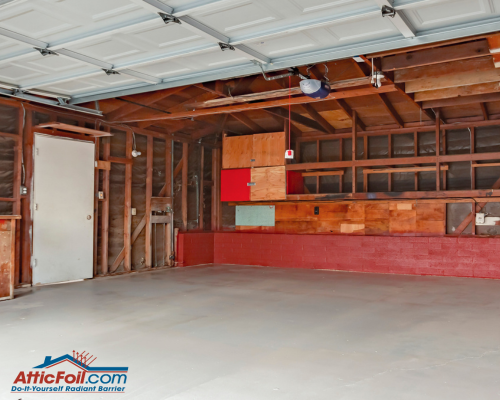Residential Garages are Non-Conditioned Spaces
If your garage is exposed to direct sunlight, adding a radiant barrier to the inside of the garage door and any walls that receive direct sunlight can be beneficial.
Keep in mind that a garage is typically not climate-controlled, so the goal is to reduce heat gain during the summer. To maximize results, address all surfaces exposed to direct sunlight. If your garage door is not in direct sunlight, adding a radiant barrier to it will not significantly cool the garage. Radiant barriers are effective against radiant heat, so focus on the walls and surfaces that receive sunlight.
In a garage, a radiant barrier is primarily used to keep the space cool. If you want to keep the garage warm, use traditional insulation. When you combine R-value and radiant barrier, you get the best results if you're heating the garage more than 10 hours a week.


Address The Garage Door First
Your garage door is one of the primary ways heat comes into your garage if it is hit by the sun, and the solution is simple. Adding a radiant barrier inside the garage on the door will make the biggest impact.
You can see the full directions for installing radiant barrier on a residential garage door here.
TIP
If your garage door does not catch direct sunlight, then adding the radiant barrier to the door is not going to make a difference in cooling the garage.
Step 1: Measure & Choose a Product Style


Begin by measuring your garage space and determine how many square feet of material you need. Check the spacing of the wall studs or rafters to determine if a certain size width may be better for installation.
Once you determine how much material you need, choose a style - either the perforated foil/foil product or the perforated foil/white product will work in the garage space. Many people like the more finished look of the Foil + White AtticFoil™ but both will work the same to block heat from coming in the garage.
Step 1b: Add Insulation (Optional) for Winter


In some colder areas, customers want to help keep heat inside their garage. If you’re regularly heating your garage, then you may want to consider insulating the cavities, if possible, and then adding your foil layer to face inside the garage. In the photo you see here, the customer was mostly concerned about keeping the heat inside the garage, which is why the foil is closest to the inside of the garage space.
This customer did not use sheetrock over the foil, just insulation and AtticFoil™. If he wanted to cover with sheetrock he would have needed to create airspace between the foil and sheetrock with furring strips. Alternatively, if you want the white finish facing in, you can use the furring strip method here and do the same thing.
*Note: insulation in a garage space is really only beneficial if you're heating/cooling the garage. Otherwise the best approach is to use the radiant barrier alone and have some ventilation in the garage.
TIP
Regardless of the ventilation you have in your garage, install AtticFoil™ with plenty of air gaps so the air can move around the garage and keep things cool and dry.
Step 2: Staple/Screw the Foil Onto the Frame


If your garage is framed in wood, use any size staples and attach the product to the garage walls and roofline, covering as much as you can and overlapping seams up to 2".
This part of the installation is just like a Standard Staple Up Install - so you should leave some small gaps at the peak of the roof of the garage, just like you do in the attic.
If your garage is metal framed, you can use insulation screws/locking washers to attach the product to the frame. If this is more of a hobby shop garage and you're planning to spend time in there, check out our metal building website for more products and install info: www.BlueTexInsulation.com
Try to cover all walls and the entire roofline for the best results. Adding radiant barrier will also help keep heat in the garage during cold months, especially if you use heating inside the garage space.
Finish with an Interior Cladding
At this point in the installation you have the option to continue to finish out your garage walls. Remember though, you have to maintain the air gap on the foil side!
To do this, you can add some furring strips before putting up an interior finish. Most people add OSB or drywall, but it doesn't matter what you use as long as you create some sort of air gap between the foil surface and the new interior cladding. This is just like adding foil behind siding on the outside of a house.
The gap does not have to be vented; in most all wall assemblies, the air is what is called "dead air" and doesn't vent. That's OK and will not hurt your wall or siding.






